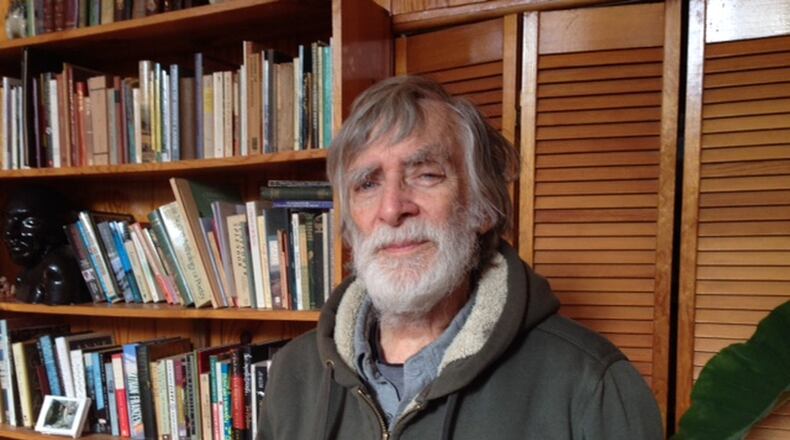Like blooms of lorn primroses blowing loose,
When autumn winds arise.
— James Whitcomb Riley
The Almanack Horoscope
Moon Time: The Blackberry Moon reaches perigee, its position closest to Earth, on August 18, and becomes the new Cricket and Katydid Moon at 1:30 p.m. on August 21. Rising after midnight and setting in the evening, this moon is overhead in the late morning.
Sun Time: A total eclipse of the Sun will occur on August 21, visible in its entirety in an area from Oregon through the center of the United States and the Southeast. The eclipse will be about 90 percent visible in Clark County, beginning about 1:00 p.m. and ending a little before 4:00 p.m. The greatest occultation will take place at about 2:30 p.m. The next solar eclipse of this magnitude will not occur again until 2024. Of course, never look directly at the sun, even during an eclipse!
August 22 is Cross-Quarter Day and marks the halfway point between summer solstice and autumn equinox. The sun enters Virgo on the same day. ]
Planet Time: Saturn lies below Hercules at sundown, disappears into the west after midnight.
Star Time: Now Libra has moved deep into the west by 11:00 p.m., with Scorpio following close behind along the horizon. The Northern Cross (or Cygnus the Swan) has moved directly overhead and will tell the time of year throughout the autumn until Orion appears in the east once again.
Shooting Star Time: The next significant meteor shower, the Draconids, occurs in the first week of October.
Weather Time: The August 17 Front: New moon on the 21st is likely to contribute to storms with this front and the next. The solar eclipse during the afternoon of the 21st may intensify lunar influence.
The August 24 Front: Now the likelihood of severe heat in Clark County is only half of what it was at the beginning of August, and this late-August high-pressure system brings chances for light frost along the Canadian border. In Springfield, however, this front usually brings little change.
Zeitgebers: Events in Nature that Tell the Time of Year: The third week of August is the week in which the Judas trees often show patches of bright orange in the otherwise solid green of maples. It is the week that elms, box elders, and catalpas start to wear thin, and showers of black walnut leaves foretell autumn.
Buckeye leaves are browning under the high canopy. Scarlet has appeared in the sumac, Virginia creeper, and poison ivy. Redbuds and cottonwoods can be yellowing from the heat. It is high bloom for velvetleaf, jimsonweed, prickly mallow, wild lettuce, ironweed and wingstem, but teasel and tall bellflower time is over. Elderberries are ready for wine.
Field and Garden Time: Most summer tomato plants, set in the ground around Memorial Day, are producing fruit. Before frost, pick and preserve some marjoram, sage, clover, and fennel to feed to your ewes and does after birthing. Some owners say these herbs stimulate increased milk production. Also collect and freeze colostrum for your winter lambs. Plant or divide lilac bushes. Prune your privet hedges.
Marketing Time: Plan breeding times for ewes and does in order to serve next year's markets: (Mardi Gras on February 18, Chinese New Yer on Feburary 16 and Dominican Republic Independence Day on February 27.
Mind and Body Time: As the summer progresses, look for the first signs of a pre-autumn surge in energy and euphoria. This surge may reflect an ancient biological trigger that helps people prepare for winter; take advantage of it to finish your summer projects.
Creature Time (for fishing, feeding, bird watching): Expect a lull in the fish activity after the August 17 front goes east, but then an increase as the August 24 high-pressure system approaches. Since the moon will be overhead in the middle of the day, lunch time should favor locating fish and other creatures. In August, the last spicebush swallowtails visit the garden. Tiger swallowtails and giant swallowtails often remain into September. Murmurations of starlings become more common, and long flocks of blackbirds follow the harvest.
Journal
I have been making notes about the seasons in a daybook since 1978. Each day’s post contains observations of common events in nature in my neighborhood, village and nearby parks.
I have learned that events in nature occur more or less at the same times each year. Sometimes I see trends, and I enjoy comparing the quality of seasons. I enjoy finding new things the more I look.
What is most rewarding in all of this is discovering my life in the observations I make. The daybook has become an autobiography in the sense Jean-Jacques Rousseau expressed in his Reveries of the Solitary Walker. When Rousseau went back through his botanical collections, he relived his life within what he felt was the idyllic context of his informal research. His collection of plants became a kind of filter for his view of the past that only allowed the tranquility of his nature walks and his thoughts and daydreams of the time to shine through.
As I look through the notes I have made, I remember the tranquility that surrounded my own experiences of discovery and recording. I hold on to what Rousseau called “accessory ideas” that my entries evoke, and I see that the practice of noticing the world and of finding myself in it and of making myself part of its story has been so much of my life.
About the Author
